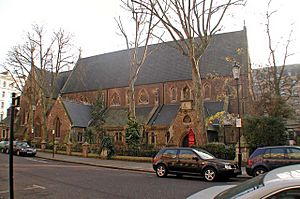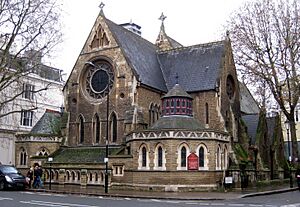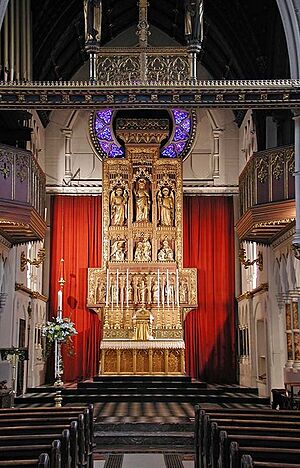St Stephen's, Gloucester Road facts for kids
Quick facts for kids St Stephen's Church, Gloucester Road |
|
|---|---|

St Stephen's, Gloucester Road
|
|
| 51°29′45″N 0°11′01″W / 51.4957°N 0.1836°W | |
| Location | Gloucester Road, Brompton, London |
| Country | United Kingdom |
| Denomination | Church of England |
| Churchmanship | Anglo-Catholic |
| Architecture | |
| Architect(s) | Joseph Peacock |
| Years built | 1866–1867 |
| Administration | |
| Deanery | Chelsea |
| Archdeaconry | Archdeaconry of Middlesex |
| Episcopal area | Kensington (Bishop of Kensington) |
| Diocese | Diocese of London |
St Stephen's Church, Gloucester Road, is a beautiful Anglican church in South Kensington, London. It is a very important building, listed as Grade II* for its special history and architecture. You can find it at the corner of Gloucester Road and Southwell Gardens.
Contents
The Church's History
Building St Stephen's Church
In the mid-1800s, many people were moving to South Kensington. The Gloucester Road tube station also opened in 1865. Because of this growth, a church leader named Rev. John Sinclair bought land. He wanted to build new churches, including St Stephen's.
First, a temporary church made of iron was put up in 1865. This was on the east side of Gloucester Road. While it was being used, plans were made for a permanent building.
The main church building was constructed between 1866 and 1867. The architect who designed it was Joseph Peacock. The church was finished, but a tall tower was never added. The new building was officially opened for worship on January 10, 1867.
Changes Over Time
The first vicar, Rev. J. A. Aston, followed an Evangelical style of worship. This means he focused on personal faith and the Bible. However, the vicars who came after him, Rev. J. P. Waldo and Rev. G. Sutton Flack, changed the church's style. By the late 1800s, St Stephen's became more High Church. This style includes more traditional ceremonies and rituals.
In 1887, architect Hugh Roumieu Gough added a special octagonal room. This room is called a vestry, where priests prepare for services. He also added a lady chapel, which is a small chapel often dedicated to the Virgin Mary.
Beautiful stained glass windows were put in during the 1890s. These were designed by Nathaniel Westlake. More changes happened after Rev. Lord Victor Seymour became vicar in 1900. Architects George Frederick Bodley and Walter Tapper added a fancy wooden screen behind the main altar. This screen is called a reredos. They also built special areas for the choir and the organ. The church continued to be updated throughout the 1900s, especially in the 1930s.
St Stephen's Today
Worship and Music
St Stephen's Church holds several Masses (church services) on Sundays and during the week. These services often feature music sung by a professional choir. The church has a large organ, which was first built in 1905 by Norman and Beard. It was made even bigger in 2001 by T. W. Fearn & Son.
Church Traditions
St Stephen's is known as a traditional Anglo-Catholic church. This means it follows older traditions of the Church of England. For example, it does not allow women to become priests or bishops. Because of this, the church receives special guidance from the Bishop of Fulham, who is currently the Rt. Rev. Jonathan Baker. This special guidance is called alternative episcopal oversight. The church is also a member of an organization called Forward in Faith.
Famous Connections
T. S. Eliot's Time at St Stephen's
St Stephen's Church has a special link to the famous poet T. S. Eliot. After a difficult time in his life, Eliot found comfort and spiritual help at St Stephen's. From 1933 to 1940, he lived in the church's vicarage (the house where the vicar lives). He lived at 9 Grenville Place from 1934 to 1937, and then at 11 Emperor's Gate from 1937 to 1940.
The church played a big part in his journey to Christian faith. He learned about the traditions and practices of Anglo-Catholic worship there. For 25 years, he served as a churchwarden at St Stephen's. A memorial was placed in the church after he passed away to remember him.
Christopher Lee's Connection
The well-known actor Christopher Lee also had a connection to St Stephen's. He served as an altar server at the church after World War II. An altar server helps the priest during church services.
Vicars of St Stephen's
Here are the priests who have served as vicar of St Stephen's since 1867:
- 1867–1871: The Rev. John Astbury Aston
- 1871–1894: The Rev. Joseph Peter Waldo
- 1894–1900: The Rev. George Sutton Flack
- 1900–1929: The Rev. Lord Victor Alexander Seymour
- 1929–1956: The Rev. Eric Samuel Cheetham
- 1956-1988?: The Rev. Herbert Moore
- 1988?-1995 The Rev. Christopher Colven
- 1995–2016: The Rev. Reginald Bushau
- 2017–present: The Rev. Philip Barnes



